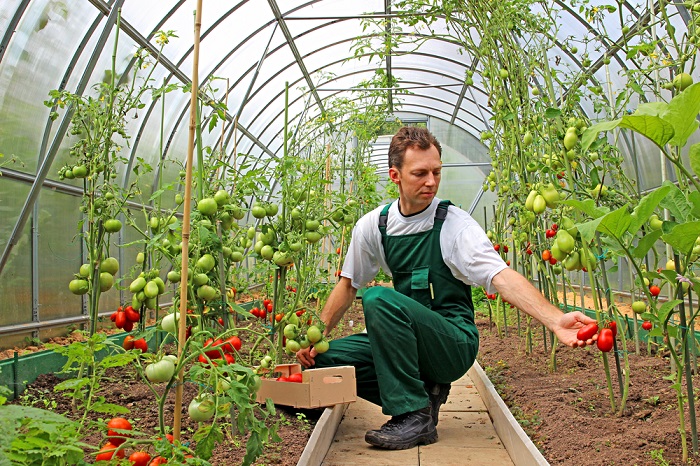November and December are good months to evaluate the past year’s operation and make changes that will increase income the following year. There are several ways to make more money and improve your profit margin using the same amount of greenhouse space.

Evaluating the Past Year
Start by asking yourself questions that will help you identify the successes and problems of the past year. Some needed changes will become apparent immediately.
Product Lines
Were you able to sell everything you produced? Did you sell out of certain varieties early? Do you think you could have sold more? Were there slow-selling varieties you can replace with stronger sellers next year? Did planting in succession provide a continuous supply of plants to sell throughout the marketing season? Were flats germinated and plugs transplanted at the right times for anticipated sales?
Could you have started seedlings earlier for greenhouse vegetable production? Do you need to find varieties that start producing earlier and keep producing longer? Did you sell any unique varieties of plants and vegetables? Were customers interested in them? Did customers ask for varieties they have trouble finding? Which plant and vegetable varieties did not sell?
Markets
Did you attract customers to your greenhouse? Were they more of a nuisance than benefit? Did you sell enough from your greenhouse to merit regular hours? Can you attract more people to the greenhouse with better-placed signs or strategically placed flyers?
Are you happy with your other retail markets? Are there ways to expand sales there next year? Was it too time consuming or expensive to transport products to sell at another location?
Did you make enough money on your wholesale contracts? Do you want to increase or decrease wholesale markets? Was delivery too costly or time consuming?
What new or potential markets did you locate? Now is the time to check out these markets. They will require variety and quantity changes in your product line next season.
Profits
The most important financial question is “Did I/we make a profit?” This is different from “Did I/we generate revenue?” You can generate a lot of revenue and not make a profit. If you have kept careful track of your income and expenses, you can calculate your profit (net income) for the year by subtracting your expenses from your income. Remember to include a portion of your greenhouse, equipment, and other capital costs. To calculate earnings per hour, divide your total profit by the total number of hours worked.
How much profit was made on plants sold in packs, pots, and hanging baskets? Did you get a premium price for vegetables grown and sold before or after the local season? Profit margins will generally be lower on products sold wholesale. Are you satisfied with the profit made on all products retail and wholesale?
Preparing for the New Year
Regardless of the size of your operation, the goal is to increase profit without decreasing the quality of your products. There are several ways to do this using your present greenhouse.
Reduce expenses. Profits can be increased, simply by reducing expenses.
Growing plants from seed and producing your own cuttings costs less than buying rootstock, cuttings, and plugs. Choose disease-resistant varieties that are easy to germinate and root. Plants that require a longer growing period can be started early on a well-lighted shelf in the house or in a well-insulated germination chamber. Seed prices vary greatly. Fortunately, there are plenty of popular varieties, which are less expensive. When choosing an expensive variety, plants can be planted earlier and sold in larger pots or hanging baskets for a higher price per plant.
Buy supplies in case quantities to obtain better prices. When cases are too large, you may be able to split them with other small growers or sell extras to customers, adding a reasonable markup.
Items can be found at yard sales, auctions, or recycling centers and used for benches, worktables, and tubs for planting and watering. Inexpensive plastic can be found, sometimes free, for temporary plant shelters and double and triple covers in the greenhouse.
Use the lowest technology appropriate for any given job. Avoid high-priced, high-tech gadgets until you are certain they will save you time and money. There are inexpensive, low-tech methods of planting, watering, fertilizing, and doing other tasks required.
Saving on heat is one of the best ways to save money. Organize the greenhouse separating plants requiring more heat from those that require less. Enclose plants requiring more heat in a smaller area. Use double and triple covers or insulating blankets inside the greenhouse over lettuce, spinach, root crops, peas, and cole crops, planted in the ground. Bedding plants such as broccoli, cabbage, and greens require less heat than tomatoes, peppers, and melon plants.
Maximize the Use of Space
Creative use of greenhouse space can increase the number of plants and vegetables you can raise. Flats and pots can be set between rows of small, transplanted vegetables and sold before the transplants need that space. Quick growing transplants, like lettuce and spinach, can also be planted between rows of tomatoes or pepper plants and harvested before larger plants cover them. Peas and cucumbers can be trellised, requiring very little space.
The ceiling of a heated greenhouse requires no additional heat. Hanging baskets can add income. Benches with a single row of plants can also be hung from rafters or trusses, provided they are spaced far enough apart to allow enough light to penetrate to plants below.
Increase Price and Volume
Never retail your plants or vegetables for less than their price in local stores and nurseries. Your quality is significantly better. Customers will notice the quality and pay at least the same price. Some are willing to pay more. Vegetables, grown naturally in the greenhouse and sold before and after local produce is available, sell for a premium price.
Fresh salad greens, peas, broccoli, and root crops can be raised and sold November through April, extending your sales (and providing you with high quality vegetables through the winter).
Spring plant sales can generate additional money by offering specialty plants and products not easily found other places. Bicolor and tricolor baskets are fuller and far more striking than single color baskets. They are stunning and immediately catch people’s attention. Hanging baskets and large containers with fruit and vegetable plants, bred to produce in baskets, are popular with apartment gardeners. Large tomato plants, already setting fruit, are popular with by some early gardeners. Potted flowers in bloom and large herb plants sell to people who want instant color. All sell for higher prices and provide a higher profit.
Move early garden plants to a temporary shelter to harden off before they are sold and create space for additional transplants or flats of quick growing bedding plants like squash, melons, and zinnias.
Eliminate wholesale contracts and replace them with retail sales when possible. Selling retail usually provides a larger profit margin than selling wholesale, but you will need to add time and costs for marketing.
Improve Profit Margin, Net Income and Hourly Wage
The ratio of production costs to sale price varies with different types of operations and products.
Planting seeds and transplanting into hanging baskets costs less and requires less time than planting seeds into flats for bedding plant sales.
Buying a few seeds and planting early vegetable crops in the ground of the greenhouse costs significantly less than planting large numbers of seeds in flats, pots, or hanging baskets using a commercial growing medium. The amount of time required may also be less until harvest. But one transplanted tomato will continue to provide tomatoes to sell or eat for several weeks.
The financial variables are numerous and need to be considered for each type of product. Calculating profits earned on each product will allow you to choose those products that provide more net income and add them to your revised plan.
To improve your hourly wage, be efficient. Group tasks and organize your workspace to minimize non-productive time. The fewer hours you work the higher your hourly earnings will be.
Diversify Sales and Add Non-Greenhouse Sales
When customers buy vegetable plants for their gardens, they are likely to buy hanging baskets, flower and herb plants, and early vegetables if they are available. Some customers will return for vegetables until their gardens begin to produce.
Some products are a natural extension of the greenhouse and can add profit to your sales. Plants grown in the greenhouse can be used to raise field vegetables and cut flowers and herbs. Landscaping and planting services can be offered. Classes, workshops, and tours attract potential customers and sometimes they can provide additional income.
Garden supplies can be sold. Those hard to find in the bigger stores in our area, include tomato stakes, insecticidal soap, Bt (Bacillus thuringiensis), rotenone and pyrethrum concentrates, finely-ground agricultural lime, and insulating blankets. You already have extra flats, packs, hanging baskets, pots and other greenhouse supplies to resell to customers.
Other products you raise can be sold as well. Fresh berries, rhubarb, and orchard fruits sell easily. Honey, jams, and jellies, made from your own fruits, delight customers. Eggs and meat products require refrigeration and must comply with state or county laws regulating their sale, but these naturally raised products are gaining wider popularity among customers.
Gini Coover is the author of The Natural Greenhouse, Growing Plants and Food for Profit. She has grown greenhouse plants and vegetables for over 30 years.
Related Articles & Free Email Newsletter
Creative Retail Contracts Help Sales
Finding Customers in Difficult Times
Growing Healthy, Productive and Profitable Plants through Succession Planting




Comment here